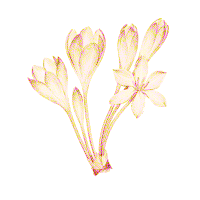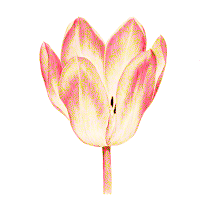![]()

![]()
Now that autumn is almost upon us many gardeners are thinking about buying and planting bulbs. So while you are perusing your catalogues and visiting garden centres to see what is available here are a few facts about bulbs in general.
First, the big, the small and the tall. The largest bulb in the world is probably that of the hippeastrum, or amaryllis. This impressive house-plant produces enormous trumpet-shaped blooms at Christmass and New Year. How one can ever tell which is the smallest flowering bulb I don't know, but it is reported that several vie for that honour. Among them are Anemone coronaria, Fritillaria meleagris, snowdrops and some alliums. The world's tallest bulbous plant is the giant Himalayan Lily, known botanically as Cardiocrinum giganteum. Given the right conditions this plant can grow to a height of 12ft. Its stem is very thick, and, during the summer, it bears tubular, creamy, purple-streaked flowers.
But maybe you prefer something old, in which case look for the tulip variety 'Keiserscroon', which was first introduced in 1750. There is an older variety in existence, 'Lac von Ryn', which can be found growing in the Hortus Bulborium in Holland. The Hortus Bulborium, in the Dutch town of Limmen, is a unique living museum of rare and unusual bulbs. It contains an unrivalled collection of centuries-old tulips, narcissi, hyacinths, crocus and fritillaria, supplying genetic material for plant breeding throughout the world.

COLCHICUM AUTUMNAL
There is a bulb whose leaves and flowers don't seem to like one another. This bulb, Colchicum autumnale, is also called Naked Ladies or Naked Boys because, when it blooms in October and November, it displays its bare-stemmed goblets of purple, pink or white flowers with not a leaf in sight. The glossy strap-like leaves don't appear until spring, well after the flowers have died. It is also known as Meadow Saffron, and it can be found growing wild in damp meadows in East Anglia, Yorkshire and woods in the Cotswolds and Wiltshire. There are approximately 35 bulbous species native to Britain, from the bluebells, ransoms and other wild onions to such rarities as the yellow Star of Bethlehem, snowflake, wild gladiolus and Snake's Head Fritillary. Other bulbs growing wild include the Meadow Saffron, Grape Hyacinth, Lily of the Valley, and both the spring and autumn squill.
If you are fond of garden visiting, try Keukenhof. Over seven million bulbs are planted each year at the 70 acre Keukenhof gardens, at Lisse in Holland, to guarantee a spectacular display of blooms in spring. Among them are colour coordinated associations of tulips, hyacinths, muscari, anemones and fritillarias. Each year the bulbs are all lifted and every bed is resown with grass seed, new beds being cut into the older grass. This is to prevent the soil becoming bulb sick. There you can see some of the 2000 varieties of daffodil in cultivation around the world. Botanically called narcissus, they have been divided into twelve distinct groups for ease of identification, with Division 1 containing the typical large trumpet daffodils we know so well. You will also see plenty of tulips. Tulips originally came from Turkey, the name being derived from either the Turkish word tuliband or the Persian word thoulyban, both of which translate into English as 'turban'. The first tulip species arrived in England in 1577 but they created little interest here or on the continent. There is a story that a bulb merchant in Antwerp fried and ate a consignment of tulip bulbs because he couldn't sell them and he didn't want to waste them (fifty years later and he would have made a fortune). In France, between 1610 and 1620, the price of tulip bulbs started to rise rather fast, but in Holland in 1634, tulips soon became a status symbol and led to tulipmania throughout the country. During their peak popularity individual tulip bulbs of rare and unusual varieties sold for vast sums of money. Holland is famous for its bulbs, and in 1925 an organization called The International Flower Bulb centre was set up. This is an organization which promotes Dutch bulbs worldwide. At present there are about 3500 bulb growers in the Netherlands growing over 15000 hectares of bulbs. That`s just about 60 square miles. They also manage to export more than two thousand million tulips to about 80 countries throughout the world. That is an average of roughly 45 tulips a minute for the whole year to each of those 80 countries. I wonder where they all go to.

COTTAGE TULIP
And talking of tulips, a tulip seed takes about 5 years to grow into a bulb large enough to produce its first flower. If the new variety looks promising, with maybe a new colour or form, it may go into production. It can then take many more years to bulk up stocks of bulbs ready for sale. But will you be able to produce a jet-black tulip? Not according to the breeders who declare that true black does not occur in nature. The closest they have come is 'Queen of the Night' and 'Recreado'. However a true red daffodil may well become a reality. There are several pink varieties being sold including the coral pink 'Salmon Spray' and deep pink 'Romance'. I have seen pink daffodils and I don't like them!!
Bulbs can be propagated from offsets. This can be a slow procedure if you want a lot of bulbs quickly. Many bulbs which naturally reproduce slowly from offsets can be encouraged to develop dozens of bulblets simply by making a cross cut in the base of the bulb. Hyacinths and Crown Imperials are particularly responsive. Lilies can be propagated from scales taken from the outside of the bulb, and some lilies even produce little bulbils in the leaf axils up the stem which can be picked off and treated as bulbs, though it will be a few years before they flower.
Maybe you would like to have hyacinths in bloom for Christmass. What you need are prepared bulbs. Prepared hyacinths undergo a very precise temperature treatment to encourage them to flower within 10-12 weeks of planting. At the nursery the bulbs are harvested and stored at a temperature of 23°C (73°F) for ten days. The temperature is then increased to 25°C (77°F) for two weeks. They are then stored at 17°C (63°F) until ready for planting. Hyacinth bulbs can cause skin irritation to some people, so be careful when handling.
Either wear gloves or wash hands well after handling. If you go to a little trouble, you could have bulbs flowering in your garden all year round. Plant Crocus imperati to flower in January, snowdrops, dwarf iris and winter aconites (February), Chionodoxa and Anemone blanda (March), Ipheion, daffodils and hyacinths (April), tulips (May), Allium (June), Ranunculus and lilies (July), Galtonia and gladioli (August), Sternbergia (September), colchicums (October), crocus and nerines (November), and Cyclamen coum (December).
Happy Gardening
written by Bill Hutchings
![]() Return to the September 1997 Features page
Return to the September 1997 Features page
![]() return to Home page and main index
return to Home page and main index
page last updated 1 SEPTEMBER 1997